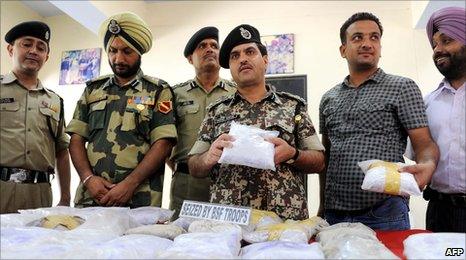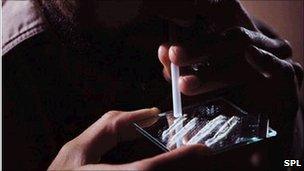Punjab's drugs epidemic
- Published

Another day, another drugs bust for the Punjab's police
In the ruins of an abandoned house close to India's border with Pakistan, three friends gather to take smack.
They are not down-and-outs, but students, who we are told are from "good families".
They live in Tarn Taran, a typically bustling market town in Punjab, one of India's wealthiest states.
They burn the brown powder, a low grade form of heroin, over metal foil, and then inhale the smoke it makes though a rolled-up 50 rupee ($1) note.
"I started taking it when I was at school," one tells me.
"Smack is easily available at all the schools and colleges in the border area. I reckon that most of the 18 to 25 year olds here take drugs," he says.
'Time bomb'
Punjab has had a drugs problem for many years, but what the student says confirms the widespread fear that things there have recently become much worse.

A new study in Amritsar estimates that 70% of young Punjabi men are hooked on drugs or alcohol
All sectors of society have been affected, including ones you would least expect.
Tarn Taran's government-run rehabilitation clinic is treating a policeman, two farmers and a professional wrestler.
"It's as if we're sitting on a time bomb that can explode at any time," said Dr JPS Bhatia, who has run a rehab clinic in the region's main city, Amritsar, for the past 15 years.
"It [the rate of addiction] is definitely on the rise and it is increasing so much that the scenario at the moment is that of an epidemic," he said.
No-one knows exactly how many new addicts there are, but a recent study by the Guru Nanak Dev University in Amritsar suggested that as much as 70% of young Punjabi men were hooked on drugs or alcohol.
While the well-off take heroin, the poor take sedatives or other cheap medicines that are easily available at pharmacies, despite government efforts to limit access to them.
Historically, India's north-eastern region, next to Burma and close to the poppy-growing regions of the Golden Triangle, has had the most addicts.
Willing customers
But the bulk of the world's heroin now comes from Afghanistan, and its main route into India is through Punjab, via Pakistan.
It is a heavily guarded frontier, but cross-border gangs know well how to exploit gaps in the fence.
"What they do is put the contraband in large tyre tubes and float them across the water so that the person on this side of the border can collect it," said Tarn Taran's police chief, Pritpal Singh Virk.
"Certainly I'm worried about it and so are my high-ups. My seniors are always on to me to catch more smugglers and more drug peddlers and we're doing it," he said.
But despite frequent drug seizures, more keeps coming in.
Just as importantly Punjab, with its growing economy, has an ever larger number of willing customers.
The area's main wealth comes from its farms, and several times I hear stories of landowners selling their property to feed their habit.
"The middle class and the affluent are the worst victims of this crisis," explained Dr Bhatia.
"They are not labourers who don't have to worry about getting up in the mornings. They can sit at home taking heroin, while someone else does their work," he said.
Village of widows
One of Dr Bhatia's patients is Vishal Bamber. He actually became hooked on heroin in England where he lived for 10 years, and only returned to Punjab last year.
He did so because he said the treatment here is much more effective than what he was receiving in London.
But while his own experience of India might be hopeful, Mr Bamber has been horrified to see what has happened to the place while he was away.
"I was, like, oh my god, what's happened to my home? It used to be so clean but the vibes have changed and I'm so shocked," he said.
"There was a time when there was prosperity in this state, people were so energetic doing things, trying new things. But this is now such a sad state. The map of Punjab has changed."
One of the worst affected areas is Maqboolpura, on the edge of Amritsar.
So many of its men have died or deserted their families after becoming addicted that it has become notorious for being "the village of widows".
One woman I meet has lost two husbands, and is now struggling to care for her new one, and her eldest son, who are both addicts.
'Gutless'
At least there is hope for most of the children of the area - a charity school run from the house of the headmaster.
"The situation here is pathetic, pathetic," its director, Brij Bedi, told me.
"We encounter drug addicts in the daytime. Sometimes they become very violent also. They're drunk or have taken drugs.
"Sometimes they try to abuse also, but they don't bother us, we're very bold, we're very strong, we're not scared of them.
"At least the children won't touch drugs. They've taken a pledge that they'll fight drug abuse," he said.
"Some want to become lawyers to get justice for the people of this area, while some want to become police inspectors to catch those people who sell it.
"The police know exactly who sells the drugs, but the tragedy is they are helpless. They are gutless people."
There are many critics of the government, but according to Dr Bhatia, Punjab is now waking up to the problem, and beginning to understand how to treat it.
"They say that growth always comes from a crisis situation, and so as we have a crisis here in Punjab there is growth also. We can be very positive that things are moving in the right direction."
But he admits that a much greater effort is needed if this problem is ever to be contained.